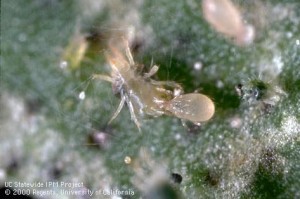 Work by Dr. Frank Zalom’s group at UC Davis has shown that applications of bifenthrin (Brigade/Bifenture) and λ-cyhalothrin (Warrior with Zeon) applied at hullsplit for NOW control negatively impacted the population of the predatory mite Galendromas occidentalis
Work by Dr. Frank Zalom’s group at UC Davis has shown that applications of bifenthrin (Brigade/Bifenture) and λ-cyhalothrin (Warrior with Zeon) applied at hullsplit for NOW control negatively impacted the population of the predatory mite Galendromas occidentalis
In the study, G. occidentalis mites were placed onto ‘Butte’ and ‘Nonpareil’ branches that were sampled from an orchard at 1, 111, and 194 days post hull-split pesticide application. After 72 hours, the number of females that were still living, the number of eggs laid, and the number of eggs that hatched were counted. The group found both short term and long term effects on adult survivorship and the number of eggs laid. With applications of bifenthrin, 30%, 20%, and 14% fewer adults survived and 50%, 33%, and 24% fewer eggs were counted at 1, 111, and 194 days post application, respectively. With applications of λ-cyhalothrin 50%, 35%, and 14% fewer adults survived and 84%, 58%, and 28% fewer eggs were counted at 1, 111, and 194 days post application, respectively.
Seeing these results, they came to several conclusions:
1. Even 6 months after the application of the selected pesticide, residues had a negative impact on the survival of G. occidentalis exposed and number of eggs laid. This data did not take into account the immediate/direct effects of the pesticide application (which are known to be severe);
2. Insecticide residues remaining on treated surfaces can have a negative impact on the following season’s migrating and overwintering beneficial mite population, indicating that the use of some pyrethroids have a larger, persisting negative impact on the population of predatory mites;
3. If possible, pesticides that reduce the negative impacts on beneficial/predatory mites should be selected;
4. Consideration should be given to the long term effects and impact on beneficials as pesticides are being developed or applied as it is clear that the effect of pesticides are more complex than previously thought.
This work is in support of the field observations of which spider mite control is often difficult the following year(s) after applications of pyrethroids.


tom martin
August 10, 2013David,
Your findings here support our experience many years ago when we used insecticides to control byrobia mite – we had outbreaks of two spotted mite and it took a few years for the predators to stabilise again after we substituted winter oil sprays to control byrobia.
However last year our Carob Moth numbers were very high, with ID on nuts sometimes 3-4% and numbers in the stockpiles in the millions (requiring fumigation which is not normally required).
We are ordering traps to monitor the cycles of CM in the spring and expecting to have to spray at least one insecticide.
My concern is that this will damage mite predator levels (as you have just explained) and we will have big mite numbers.
Do you have any tips please?
Thank you,
Tom.
David Doll
August 10, 2013Tom,
Further research by Dr. Zalom and others has shown that the use of IGRs and Calcium disruptors will have a smaller effect on the beneficial population of mites while providing control of moth pests. Based on his 2008 report, Zalom has shown that the use of Intrepid (Methoxyfenozide) and Altacor (rynaxypyr) are able to control moth pests without doing too much damage to the mite populations in comparison to the control. This is in contrast to the pyrethroids which tend to kill mite predators as well as targeted moth pests.We think that most of the other new reduced risk chemistries will have similar effect as Intrepid and Altacor on beneficials, but we wont know until the tests are performed.
So to answer your question – try to avoid the use of pyrethroids when possible. This is a great chemistry with a short PHI, but the risks of mite flare ups for the current and future year are great. If possible, substitute in some type of reduced risk chemistries when making your applications to control carob moth. I think you guys have Altacor registered for use in Australia, but I am unsure about the other pesticides.
Hope that helps,
David